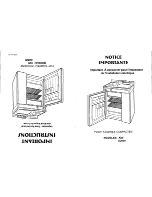
31
30
Troubleshooting
Troubleshooting
Electrical Shock Hazard
Plug into a grounded 3 prong outlet.
Do not remove ground prong.
Do not use adapter.
Do not use an extension cord.
Failure to follow these instructions can result in death,
fire, or electrical shock.
Explosion Hazard
Keep flammable materials and vapors, such as
gasoline, away from refrigerator.
Failure to do so can result in death, explosion, or fire.
Freezer control and lights are on, but
compressor is not operating
Refrigerator is in defrost mode.
Normal operation. Wait 40 minutes to see if
compressor restarts.
MeatSavor™ drawer temperature is
too warm
Control settings are too low.
See page 5 to properly adjust controls.
Refrigerator does not operate
Refrigerator is not plugged in.
Control is not on. Fuse is blown or
circuit breaker needs to be reset.
Power outage has occurred.
Plug in refrigerator.
Properly adjust controls. Replace blown
fuses. Check circuit breaker and reset.
Call local power company to report outage.
Refrigerator still won’t operate
Refrigerator is malfunctioning.
Unplug refrigerator and transfer food to
another refrigerator. If another refrigerator
is not available, place dry ice in freezer
section to preserve food. Warranty does
not cover food loss. Contact service for
assistance.
Food temperature is too cold
Condenser coils are dirty.
Refrigerator or freezer controls are
set too high.
Clean coils. See page 24.
Properly adjust controls.
Food temperature is too warm
Door is not closing properly.
Controls need to be adjusted.
Condenser coils are dirty.
Rear air grille is blocked.
Check for internal obstructions that are
keeping the door from closing properly.
Refrigerator is not level. See Installation
Instructions for details on how to level
refrigerator. Check gaskets for proper seal,
clean if necessary. See page 24.
See page 5 to adjust controls.
Clean coils. See page 24.
Check the positioning of food items in
refrigerator to make sure grille is not
blocked. Rear air grilles are located under
produce drawers.
PROBLEM
POSSIBLE CAUSE
WHAT TO DO
Food temperature is too warm
Doors have been opened frequently
or have been opened for long
periods of time.
Reduce time door is open. Organize food
items efficiently to assure door is open for
shortest time possible.
Refrigerator has an odor
Compartment is dirty or has odor
causing food.
Clean according to page 25.
Water droplets form outside of door
Check gaskets for proper seal.
Humidity levels are high.
Controls require adjustment.
Clean gaskets. See page 24.
Hot, humid weather can increase
condensation.
See page 5 to adjust controls.
Water droplets form on inside of
refrigerator
Humidity levels are high or door has
been opened frequently.
Properly adjust controls. Reduce time door
is open. Organize food items efficiently to
assure door is open for shortest time
possible.
Refrigerator or ice maker makes
unfamiliar sounds or seems too loud
Normal operation
See page 29.
Produce drawers do not close freely
Contents of drawer or positioning of
items in compartments could be
obstructing drawer.
Drawer is not in proper position.
Drawer channels are dirty or need
treatment.
Reposition food and containers to avoid
interference with the drawers.
See page 11 to for proper placement.
Clean drawer channels with warm, soapy
water. Rinse and dry thoroughly. Apply thin
layer of petroleum jelly to drawer channels.
Refrigerator runs too frequently
Doors have been opened frequently
or have been opened for long
periods of time.
Humidity level is too high. Food has
recently been added.
Refrigerator is exposed to heat by
environment or appliances nearby.
Reduce time door is open. Organize food
items efficiently to assure door is open for
shortest time possible.
Normal operation. Allow time for added
food to reach refrigerator or freezer
temperature.
Evaluate refrigerator’s environment.
Refrigerator may need to be moved to run
more efficiently.
PROBLEM
POSSIBLE CAUSE
WHAT TO DO



































